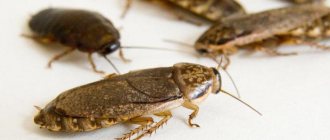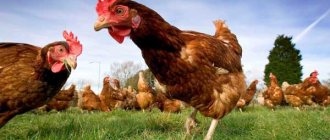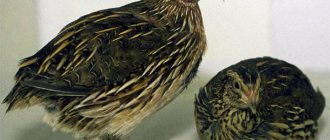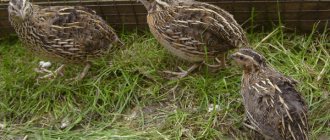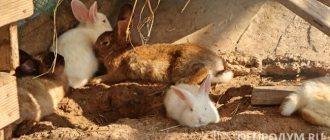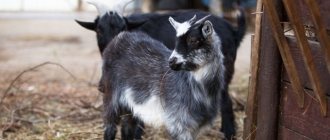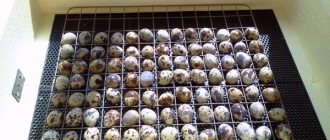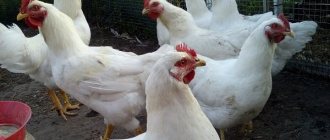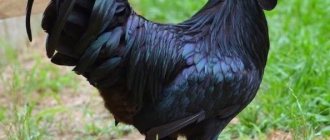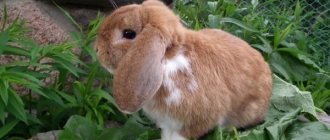All varieties of quail are divided into four groups. Some quail species are bred for eggs, others are used for meat, and others are universal, suitable for both. The fourth group of quails belongs to the decorative ones; they are kept as pets. Each variety has its own characteristics. The article tells you which breed of quail is best to choose based on the purpose of breeding, and what a beginner should pay attention to before purchasing this bird.
general information
Quails and quails are recognized by their characteristic appearance:
- weight ranges from 90-500 g, depending on the variety;
- body length from 18 to 30 cm;
- common color is yellow-brown;
- The male has a dark throat, the female has a colored throat;
- the lower part of the male’s body is light in color;
- Birds have brown stripes on their heads;
- paws are light;
- beak dark brown;
- brown eyes;
- long wings;
- short tail.
These are general signs. Some quail species and breeds have individual characteristics. For example, there are pure white quails, as well as with an admixture of black, blue or gray shades, multi-colored stripes or splashes on the feathers.
Estonian homemade
This is another breed common among poultry farmers. High productivity and early maturity are the main features that distinguish Estonian quail. The parent breeds for this variety are English White, Pharaoh and Japanese. Among other things, the advantages of “Estonians” include ease of care. This breed was approved in 1989 as an egg-meat breed. Its main distinctive characteristics include:
- rounded body shape;
- short neck and tail;
- the front part of the back is raised in the form of a hump;
- ocher-brown color of plumage with dark stripes;
- brown mandibles and cheeks in males, light gray in females;
- the presence of three yellowish-white stripes on the head of males;
- the presence of dark specks in the area of the crop and chest in females;
One Estonian quail can lay up to 275-285 eggs per year. Females begin laying eggs at the age of 37-40 days. The weight of adult individuals is 170-190 g.
The advantages of the Estonian breed, in addition to high egg production, include excellent hatchability in incubators and survival of young animals.
History of quail breeding
Where the tradition of quail breeding came from is not known for certain. There are two versions. According to the first, the Chinese started doing this. The second indicates the Japanese.
Each version has the right to life. But it is worth noting that the Japanese made the greatest contribution to the selection of quails.
In 1945, after the bombing of Hiroshima and Nagasaki, Japanese breeders were faced with the task of finding food products that could cleanse the body of radionuclides. Research has revealed that these are quail eggs.
Other facts also emerged. It turned out that they have a beneficial effect on the development of children's mental abilities. This information became the impetus for the adoption of a new law: quail eggs should be a mandatory part of the menu of every little Japanese.
Over time, scientists from other countries also began breeding new breeds of quail and improving their characteristics.
Benefit
Quail meat is a valuable dietary product and is classified as a delicacy. Tuxedo quail meat is high in calories and is valued much higher than chicken and rabbit meat, as it has high taste. It was not for nothing that quail carcasses were served on the table of kings and nobles. In Rus', quails were caught by hunting.
By eating quail meat regularly, you can significantly improve your health. It is prescribed as a therapeutic food for diseases of the heart, liver, kidneys, and lungs. The meat contains potassium, phosphorus, and B vitamins, which improve the condition of the nervous system. Quail meat is indicated for pregnant women, growing bodies, and people leading an active lifestyle.
Division into four groups
As was said at the beginning, all types of quail are divided into groups: egg, meat, meat-egg and decorative.
Quail egg breeds are a good option for those who know the value of quail eggs. You won’t get meat from these birds; the main thing here is that they lay eggs. In properly organized conditions, the annual egg production of one hen reaches 280-300 pcs.
Meat quail breeds are large in weight and the intensity of its gain. With proper fattening and an appropriate microclimate, the weight gain is 300-500 g.
Meat and egg species of quail are universal and are more suitable for breeding on private farmsteads. On an industrial scale, the first two varieties are most often bred.
The peculiarity of decorative quail breeds is their attractive appearance. Them, and not for receiving products.
Let's look at a detailed description of the breeds.
Population of NPO "Complex"
These quails were obtained by breeding “inside” the pharaohs. Specialists from the experimental factory of NPO Kompleks managed to obtain a highly productive meat-egg breed. Quails of this population gain very large live weight in a short period of time. The weight of females can reach 180-200 g, males - 150-170 g. One laying hen, under very good conditions, lays up to 260 eggs per year. The coloring of the quails from the population of NPO Kompleks is exactly the same as that of Japanese quails.
Characteristics of egg varieties
6 types
There are 6 egg breeds of quail: Japanese, Hungarian, English black and white, marbled. The difference between them lies in external signs and productivity.
Japanese
Famous quails of the egg breed. They are considered the standard by which other quail species are measured.
The weight of quails is 120 g, that of quails is 150 g. They begin to lay eggs within a month of life. During the year they produce 250-300 eggs, each weighing up to 12 g. The egg-laying period is a year. Afterwards, egg production drops by 1.5-2 times, and then stops.
Among the advantages: unpretentiousness, strong immunity, rapid weight gain. Gender differences among the “Japanese” appear at 20 days of life: males are brown, females are light ash, speckled.
Disadvantage: You won't get much meat from them.
Hungarian
Representatives of the Hungarian breed have white feathers. Sexual maturity is reached at 35-40 days. Within 365 days, they produce 300 eggs, weighing 10-11 g.
It is impossible to determine the sex of quails. You can notice the difference when the females begin to lay eggs.
English black
Quails of the English (British) black breed are distinguished by a dark shade of feathers and beak. The eyes are light.
Compared to the Japanese species, they have a higher carcass weight. However, they are not raised for meat, since the carcass looks unpresentable due to its bluish tint - a consequence of the dark color.
Egg production - 280 pcs. per year, the weight of the egg is 11 g. But in order for the quails to lay eggs well, they are housed in cages: for 3 girls - 1 boy, no more.
Disadvantage: low level of fertilization and survival of chicks - 80% each.
English white
A promising breed suitable for cultivation on an industrial scale. Used in breeding for breeding hybrid meat quails.
The advantages include the white tint of the feathers, due to which the carcass has a pink commercial tint, as well as unpretentiousness in maintenance. In 365 days, one English white laying hen produces 280 eggs weighing 11 g.
Disadvantage: you can find out the sex of quails only at one month. The difference between males is a convex gland near the cloaca of a pink hue. It is absent in females.
Read more in the article “Black and White English Quails”.
Marble
The appearance of these quails and their characteristics are similar to the “Japanese”. This is not surprising since the marbled look is derived from the Japanese.
But marbled quails look more attractive. They have a light ash color, reminiscent of a marble pattern. Egg production - up to 300 eggs weighing 11 g.
Benefits of quail eggs
Quail eggs weigh 5 times less than chicken eggs. They have a thin but strong shell. Sometimes you have to try hard to break it.
100 g of quail eggs contain 12 g of protein, 13 g of fat, 0.5 g of carbohydrates and 153 calories. They contain many vitamins and minerals and acids needed by the body.
Quail eggs:
- improve brain function;
- strengthen the nervous system;
- have a beneficial effect on the functioning of the gastrointestinal tract;
- treat stomach ulcers;
- help get rid of toxins and heavy metals;
- increase hemoglobin levels, which is important for pregnant women and children;
- normalize the condition of hair and skin;
- help in the treatment of tuberculosis, asthma, diabetes.
An important property of quail eggs is their ability to slow down the development and growth of cancer cells.
Quail pharaoh
This is also a fairly popular breed among poultry farmers. It was created by the American breeder A. Marsh through long-term selection of the most productive individuals. At the moment this is a highly productive meat breed. Pharaoh is a quail that reaches a weight of 165-265 grams. The weight of laying hens can vary between 180-310 g. Females begin laying eggs at the age of 6-7 weeks. In a year, one quail lays up to 200-220 eggs.
Some of the disadvantages of this particular breed include some whimsical maintenance and “wild” feather coloring. The carcass of Pharaoh quails is not very attractive due to the dark “stumps”.
Features of meat varieties
Moscow black
The Moscow black quail is the result of crossing English quails of both subspecies, as well as the Pharaoh. In appearance it resembles representatives of the tuxedo variety, which are described below.
These are large birds: the weight of quails is 400 g, quails are 100 g more. In 365 days, you can get about 180 eggs from one hen. But weighing 15 g.
The advantages of the breed also include high testicular fertility - up to 95%, and offspring viability - about 90%.
Pharaoh
For a long time, pharaohs were the only meat quail species in Russia. They were gradually supplanted by the “Texans,” described below.
The advantage of the breed is the large weight of quails, reaching up to 300 g, and with intensive fattening - up to 400 g. The level of egg production is low - 220 pcs. per year, but each egg weighs about 15 g.
Another advantage: rapid growth of young animals. By 5 weeks, birds gain 150 g.
Among the disadvantages: demanding living conditions and diet, dark color, which negatively affects the presentation of the carcass.
Texas white
"Texans" are calm and not picky birds. They are Texas Giant Whites and Meaty Weighted Whites.
In terms of weight, females can gain 450-500 g. The weight of males is 100 g less. Birds quickly increase their maximum weight - in 1.5 months. After processing, the carcass takes on a presentable appearance. Thanks to these characteristics, quails of this species began to be bred more and more often.
But the Texans also have negative sides. This is a small egg production (220 pcs.), Difficulties in determining the sex of birds. In addition, males are lazy and can fertilize no more than 2-3 females. A full description of the species is given in the article “Characteristics of Texas Quail.”
Phoenix
Phoenixes have a light yellow color. When exposed to sunlight, their feathers appear golden. These are calm birds that do not like conflicts.
From one laying hen you can get 200 eggs in 365 days. But the body weight is large: quails have 400 g, quails have 100 g less. Birds gain this weight within 8 weeks.
Among the disadvantages: in the room where phoenixes live, you will have to regularly maintain a certain microclimate. Which one - read the article “Description of the Phoenix Quail”.
Characteristics of quail meat
Quail meat contains a large amount of amino acids, vitamin and mineral elements. It has a beneficial effect on the organs and systems of the body.
Eating quail meat is recommended for children. It is a source of vitamin D, which prevents the development of rickets.
Quail meat helps pregnant women cope with toxicosis and replenishes the deficiency of nutrients.
With the help of quail meat, nursing mothers increase the amount of milk produced.
Older adults can improve their overall health and cope with age-related changes.
Quail meat will help athletes build muscle mass and recover faster after intense strength training.
Quail meat also speeds up rehabilitation after surgery, restores potency and strengthens bones.
Content
Currently, more and more people are trying to lead a healthy lifestyle and eat the right natural products.
The demand for quail eggs and meat is growing every year. Perhaps for some, quail breeding will become a profitable business, while others will begin to breed quail for themselves. Getting started does not require large financial investments, and results can be obtained fairly quickly. Tuxedo quail are for those breeders who are interested not only in high meat and egg production, but also in the appearance of the birds.
Tuxedo quail, like other breeds, are kept in cages. The room where the cages will be located must be warm, heated in winter, well lit and ventilated, but without drafts.
At this age, tuxedo quails better tolerate moving and adaptation to a new place. It is better to start a quail family: 4 females and 1 male. They need a cage measuring 30x30 cm and no more than 25 cm high.
A more spacious cage will negatively affect the egg production of tuxedo quails. Do not build nests; the birds will fly straight to the floor. Lay straw, sawdust, shavings or newspaper on the floor of the cage.
Clean cages regularly. The main thing is that they are not damp and do not smell of bird droppings, especially if you intend to keep quails in a city apartment.
Tuxedo quails love to take sand baths; place a container of sand inside the cage about once a week. The bathing procedure helps birds get rid of parasites.
If the birds have stopped laying eggs, then perhaps there is low humidity in the room. You can place containers of water near the cages, but do not overdo it. High humidity does not have the best effect on tuxedo quails.
Light Requirements: Tuxedo quail need 17 hours of daylight. If there are windows in the poultry house, summer and spring daylight is sufficient, but in winter additional lighting will be required. If the lighting is too bright, birds become aggressive and can harm each other. How to equip a quail cage, watch the video:
Properties of meat and egg varieties
General
Meat and egg quail species are universal. They provide both meat and eggs. There are four common varieties: tuxedo, red cap, Estonian, and Manchurian golden.
Let's take a closer look at the characteristics of each breed.
Tuxedo
The breed was so nicknamed for the unusual appearance of the birds. Their chest area is white, and their back is painted black. A small ponytail completes the look. They appear to be wearing a tuxedo.
Representatives of this species have a good weight indicator: 220 and 210 g for quail and quail, respectively. In a year, you can get about 270 eggs from one hen, weighing 11 g. The first clutch occurs at 6 weeks. Her fertility rate is 90%.
Disadvantages: inability to determine gender before puberty. This type of quail is not suitable for growing on large farms, since the egg laying rate is the lowest among other generalist quails. Read more in the article “About the tuxedo quail.”
Little Red Riding Hood
Red cap quail were selected with the participation of the Manchurian golden species. They came to Russia from Germany.
Little Red Riding Hood is a purely Russian name given to the breed for the red head of quails. In other countries they are called differently: in Ukraine - golden phoenixes, in Italy - Italians.
Among the advantages: weight of quails - 450 g, quails - 330 g, annual egg production - 280 eggs weighing 12 g. The birds have a calm character and high clutch fertility - 95%.
Estonian
A universal breed, suitable for cultivation on an industrial scale and at home. The second name for these quails is kiteverse. They have a number of advantages that distinguish them favorably from representatives of other quail species:
- egg fertilization reaches 92%;
- unpretentiousness to living conditions;
- weight grows rapidly in the first 2 weeks of life;
- egg work lasts up to 1.5 years.
Quails of the Estonian variety have distinct gender characteristics. The head of females is uniformly gray-brown. Males have three yellowish stripes there.
Manchurian gold
A distinctive feature of the breed is its light color, with yellow and brown specks. In the sun it shines gold.
The weight of quail is 200 g, quail is 20-40 g less, the carcass is an attractive light shade. You can get about 280 eggs per year from one laying hen, each with an impressive weight of 15-16 g. You will find more information about the species in the article “Breed of Manchurian Quails.”
Japanese quail
All the quails, the breeds of which were discussed above, originated from this one, first obtained in the Land of the Rising Sun. The Japanese variety is the original for all currently existing ones. The plumage of these birds is exactly the same as their wild ancestors. The weight of a male can reach 115-120 g, females - 130-150 g. Laying hens begin laying at the age of 30-40 days and lay up to 300 eggs per year. In Russia, a special variety of this breed was bred, called Moscow. It has good productivity and is very popular among domestic poultry farmers.
Description of decorative varieties
Chinese painted
Quails have an original appearance. Their colors include blue, light blue, green, red, and yellow.
These are small birds with a pleasant voice. They live in small groups. They don't fly. In 2-3 weeks, the female lays up to 7 eggs.
Californian
American crested quails have an attractive appearance. But this is the only advantage of birds - keeping them in captivity is problematic.
“Californians” find it difficult to adapt to new conditions. They must be kept in an environment as close to natural as possible. Females lay 9-15 eggs in 3 weeks.
Conditions of detention
The tuxedo, like its quail relatives, is a heat-loving bird. At temperatures below 15C they stop laying eggs. Otherwise, the conditions of detention are simple.
Cell
It is better to keep tuxedo quails in cages than in an aviary. The design does not take up much space. To keep one family - a male and four females - a cage measuring 30x30 cm and a height of 25-30 cm is sufficient. It is advisable to attach the feeders outside, since quail often rake up food. Depending on the design, drinking bowls are installed both outside the cage and inside it.
Place
Birds are shy, so loud noises and especially sudden movements should be avoided. Even dogs and cats can disturb them. Because of this, when keeping the cages at home, it is advisable to place them in a quiet, calm place. The room must be draft-free. Heated in winter, ventilated in summer. The optimal temperature is 18-22C and relative humidity 50-70%. Quails do not like dry air or high humidity. If the air is very dry, containers with water should be placed near the cages and wet cleaning should be done more often. Lighting can be natural, but not bright.
Under no circumstances should the cages be in direct sunlight, otherwise the birds will start pecking at each other.
Daylight hours are at least 17 hours. In this regard, artificial supplementary lighting is necessary in winter. With round-the-clock lighting, the birds will lay eggs well, but feed consumption will increase, and the body will quickly wear out.
Feeding
Tuxedo quails have a very fast metabolism. Therefore, they need food that covers all their needs. It is better to take factory-made feed for laying quails than to experiment with recipes yourself. 25 grams per bird. feed per day (for comparison, Texans eat about 35 grams).
Quails of this breed cannot be overfed. This will lead to obesity and decreased egg production.
They feed twice a day. You can diversify your diet with grated root vegetables (carrots, beets), cabbage (soft leaves) or pumpkin. Quails will not refuse halves of large cucumbers and greens - lettuce, nettles and dandelions. There must be clean water in the cage at all times. If there is no nipple or microcup drinking system, the water should be changed twice a day.
Care
The cage must be cleaned every day or every other day. The structure itself can be washed and disinfected once every three months. Once a week, quails can be given sand baths, thanks to which they clean their feathers and get rid of parasites.
Quails are unpretentious birds and, provided all conditions are met, even a beginner can cope with their maintenance.
conclusions
The most egg-laying breed is the Japanese quail breed.
Of the meat quail breeds, you will have to choose between Texas white and Moscow black.
Of the existing meat and egg varieties, the Manchurian golden is considered the most profitable.
For small private farms, it is better to purchase Japanese, Estonian, Moscow black and Texas quails. These are unpretentious, calm, attractive birds with good egg performance and decent carcass weight.
Speaking about which quails are best bred on an industrial scale, we can distinguish Japanese, English white and Hungarian varieties, which have an egg direction. For meat, you can choose Moscow black or Texas white. Of the meat and egg quails, Estonian ones are suitable for large farms.
For beginner, inexperienced farmers, the best quail breeds are Japanese, Estonian and Manchurian. They are easy to care for, and they do not require special conditions.
British blacks
This breed was developed in England and is also a mutation of Japanese quail. It was brought to the USSR in 1971. A distinctive feature of this variety is its dark, almost black plumage with a slightly brown tint. In terms of live weight, British quails exceed Japanese quails by about 5%. However, they are somewhat inferior in egg production.
A breed of white quail was also developed in England. It differs from the black bird only in the color of its feathers.
Reviews of bacteria for the chicken coop
Valentina Tikhonovna Ignatenko, 43 years old, Voronezh Tried to colonize Netto-Plast bacteria. At first the drug began to work, but after a month the process slowed down. I had to add a new portion, but I didn’t have any. I considered such a substrate expensive for my chicken coop, since you also need to buy sawdust along with the preparation. Sergey Ivanovich Saenko, 52 years old, Rostov region This is the second season I have been using the domestic drug “Baikal”. Laying hens are comfortable in a small 2 x 3 barn. The underlay serves as additional heating in winter. By spring, a lot of dampness accumulates just under the bottom layer. You have to thoroughly dry the chicken coop.
The best manufacturers
There are few domestic drugs on the market. Bacteria from foreign manufacturers are more common. According to reviews, the best biological products are:
- Baikal. The domestic biological product is sold in all garden stores. The bacteria make the substrate dry and warm, ideal for broilers and layers.
- BioGerm. The German biological product is produced in light brown granules. In addition to bacteria, the product contains special additives - fragrances that block bad odors inside the chicken coop.
- Netto-Plast. The Chinese biological product contains lactic acid bacteria, as well as synthetic enzymes. The action of the product is considered rather weak. Heat generation is limited to a temperature of + 25 ° C, but this is enough to keep laying hens. It is convenient for bacteria to colonize the chicken coop substrate in the summer.
- Bioside. The domestic drug is an analogue of the Chinese drug. Once the bacteria have colonized, there is no need to water the substrate. The heating temperature of organic matter reaches + 20 °C.
Biological products work on the same principle. There is no point in looking for expensive imported analogues. The main thing is to avoid buying a fake.
The video shows deep litter:
Review of bedding options for a chicken coop with bacteria
Preparation for chicken coops BioGerm (Germany). It is a light brown powder. Designed for keeping chickens on deep, permanent litter. In addition to bacteria, the product also contains special fragrances that eliminate unpleasant odors. Consumption of the drug - 100 grams per 2.5 sq.m. BioGerm is applied in two layers: part of the powder is evenly distributed onto sawdust or small shavings 20-25 centimeters thick, spilled with water, then another layer of 20 centimeters is added, the rest of the preparation is added and moistened with water again.
After just a couple of hours, the chickens can be released onto the finished base. The service life of the drug is up to two years. A kilogram package of Bioherm costs 4 thousand rubles.
Fermentation litter "Netto-Plast" (China) is a modern biological product based on fermented lactic acid and photosynthetic bacteria. Effectively processes bird droppings, while releasing a large amount of heat (temperature on the litter surface is 25 degrees).
Baikal EM-1 instructions
Packaging from LLC “EM-Cooperation”
Dilute EM preparations only with water that does not contain chlorine! The acidity of the EM preparation (pH) is 2.8-3.5.
Consumption rates for finished concentrate
The Baikal EM-1 solution, which is available as a liquid concentrate in white plastic bottles with a capacity of 100, 250, 500 and 1000 ml, cannot be added without dilution! It already has a nutrient medium for microorganisms - there is no need to add molasses, sugar or honey, just dilute it with water:
- to treat seeds before sowing, dilute the contents of the bottle 1:1000 and soak the seeds for 30-60 minutes
- To prepare the soil, dilute the contents of the bottle 1:1000 and thoroughly water the soil at the rate of 3 liters of working solution per 1 square meter. m of land: 7-10 days before planting in spring or immediately after harvesting
- for leaf spraying of young seedlings, dilute Baikal EM1 in a ratio of 1:2000 and spray the leaves every 7-10 days
- for leaf spraying and watering of mature vegetative plants, dilute the EM preparation in a ratio of 1:1000 and spray or water every 10-14 days; It is useful to treat plants that are in unfavorable conditions (hypothermia, change of location, signs of diseases in alternation with fungicides, etc.), the application rate is 2-3 liters per 1 sq. m. m of land
- to accelerate the decomposition of organic residues, dilute microbiological fertilizer in a ratio of 1:100 and water the compost heap at the rate of 5 liters per 1 square meter. m, keep in mind that the solution lingers in the upper 15-20 cm of the processed organic matter, i.e. it is advisable not to water a large pile with a large amount of solution, but to lay it in layers, alternating them with watering the EM preparation, then be sure to cover it with film
- To prepare greenhouses for planting, the manufacturer recommends diluting Baikal EM1 in a concentration of 1:100 a week before planting vegetables and spilling the soil at the rate of 1 liter per 1 square meter. m of area, in the fall you can water the soil after harvesting
How to breed Baikal EM-1
If you are preparing a solution for indoor flowers in a small amount, it is easier to use a medical syringe: for a dilution of 1:1000, take:
- 1 ml of the drug per 1 liter of water (1:1000)
- 5 ml of the drug per 5 liters of water (1:1000)
- 10 ml of the drug per 10 liters of water (1:1000)
- 100 ml per 10 liters of water (1:100)
At a concentration of 1:100, you can prepare the soil in pots, similar to greenhouse treatments: 10 ml of Baikal per 1 liter of water.
This should be done in such cases: if you have flooded the plant, the roots have rotted, you take the plant out of the pot, inspect and remove the rot, rinse the root system in a solution of a fungicide, for example, phytosporin. And scatter the soil in which the plant was growing on a tray and place it in the oven for 20-30 minutes at 200°C. Then pour into a basin, cool to room temperature and first moisten with boiled water (until slightly damp, but not damp), then water with Baikal EM-1 solution (at the rate of 2 ml per 1 liter of water). Leave for about 1 month at room temperature, covering with film, but not too tightly, and periodically moistening with a spray bottle - the earth should not dry out! After 4 weeks, other plants can be planted in this soil again (adding other components if necessary).
If you need to dilute a large amount of Baikal’s working solution, you simply dilute the contents of the bottle in a container of suitable volume: a basin, bucket, watering can, bathtub or plastic barrel. Avoid using galvanized containers.
